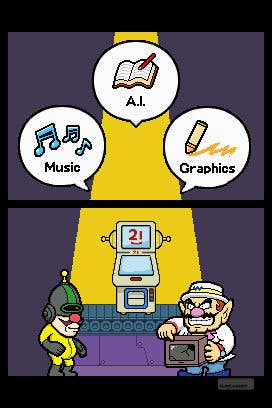WarioWare DIY
Build!
For the past few years, no series has been quite as good at deconstruction as WarioWare. Whether it's reducing plot, controls, and tutorials to a one-word prompt, slicing out art assets until you're manoeuvring a wobbly stick man across an empty void, or fitting the salvation of an entire galaxy into the space of five seconds, Nintendo's fizzing, babbling, chirping oddities manage to make games truly simple, somehow without losing any of the magic en route.
If you're after the greatest possible bang for a single press of a button, then, Intelligent Systems' ever-youthful GBA original is still probably your best bet, unless you're lucky enough to be mentally unstable and sat in a nuclear missile silo. Meanwhile, subsequent instalments have proved equally adept at handling stylus swipes, prods from the Wii remote, and even a tilt sensor, which we don't talk about any more because it had, like, mercury in it and probably contained broken glass and horse cancer too.
WarioWare DIY turns the tables somewhat by putting the focus firmly on construction. This is the WarioWare game that will let you piece together your own micro-games: creating the central mechanics, sketching in the graphics, and even pulling the soundtrack into place one note at a time. It's an interesting challenge, and one that has brought changes with it, not least the fact that a game that used to take six seconds to get something fun out of now has tutorials that last up to 20 minutes.

At Nintendo's recent media summit, I got a chance to sit down with DIY, and work through one of the very first of those tutorials. While Samus' rockets boomed through the ceiling and Yoshi burped and yelped noisily in the distance, WarioWare had turned a tiny pocket of the demonstration venue into something that felt a little bit like a school: tables and chairs were set up in rows, and people were hunched over their work.
There was only time to check out the most basic of lessons, but seeing as it has you building an entire micro-game, it offers a good sense of how usable the full package will be. The game in question is hardly an epic - in order to win, you have to prod a lazy ladybird to get it to move - but it's undeniably the kind of thing you might see in the very early stages of one of the older WarioWares.
DIY breaks the business of creating a game down into a handful of distinct sections. You sketch a backdrop, you draw and then animate your objects, you create the music, assign AI, and then decide on a win condition. Each of these sections has their own editor, and the art and music ones at least are sufficiently straightforward and entertaining to mess about with in their own right. Even if you aren't feeling confident enough to make an entire game, in other words, there's still plenty to poke around with on a bus ride and end up feeling quietly creative.









